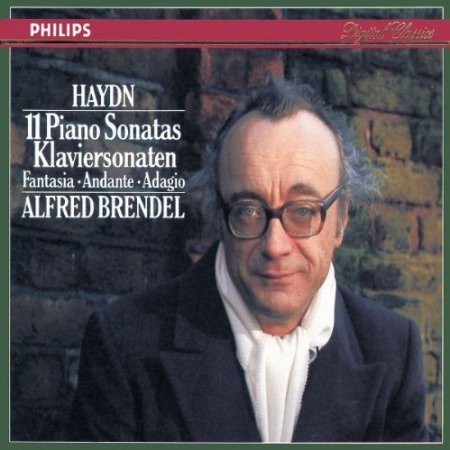Haydn Complete Piano Sonatas
View record and artist detailsRecord and Artist Details
Composer or Director: Joseph Haydn
Genre:
Instrumental
Label: Philips
Magazine Review Date: 3/1987
Media Format: CD or Download
Media Runtime: 0
Mastering:
DDD
Catalogue Number: 416 643-2PH4

Tracks:
| Composition | Artist Credit |
|---|---|
| Sonata for Keyboard No. 47 |
Joseph Haydn, Composer
Alfred Brendel, Piano Joseph Haydn, Composer |
| Sonata for Keyboard No. 50 |
Joseph Haydn, Composer
Alfred Brendel, Piano Joseph Haydn, Composer |
| Sonata for Keyboard No. 33 |
Joseph Haydn, Composer
Alfred Brendel, Piano Joseph Haydn, Composer |
| Sonata for Keyboard No. 53 |
Joseph Haydn, Composer
Alfred Brendel, Piano Joseph Haydn, Composer |
| Sonata for Keyboard No. 54 |
Joseph Haydn, Composer
Alfred Brendel, Piano Joseph Haydn, Composer |
| Sonata for Keyboard No. 56 |
Joseph Haydn, Composer
Alfred Brendel, Piano Joseph Haydn, Composer |
| Sonata for Keyboard No. 58 |
Joseph Haydn, Composer
Alfred Brendel, Piano Joseph Haydn, Composer |
| Sonata for Keyboard No. 59 |
Joseph Haydn, Composer
Alfred Brendel, Piano Joseph Haydn, Composer |
| Sonata for Keyboard No. 62 |
Joseph Haydn, Composer
Alfred Brendel, Piano Joseph Haydn, Composer |
| Sonata for Keyboard No. 60 |
Joseph Haydn, Composer
Alfred Brendel, Piano Joseph Haydn, Composer |
| Sonata for Keyboard No. 61 |
Joseph Haydn, Composer
Alfred Brendel, Piano Joseph Haydn, Composer |
| Fantasia (Capriccio) |
Joseph Haydn, Composer
Alfred Brendel, Piano Joseph Haydn, Composer |
| Adagio |
Joseph Haydn, Composer
Alfred Brendel, Piano Joseph Haydn, Composer |
| Sonata (un piccolo divertimento: Variations) |
Joseph Haydn, Composer
Alfred Brendel, Piano Joseph Haydn, Composer |
Author: Stephen Plaistow
Last December, when writing about the fourth of these recordings, I suggested they were to be counted among the best Alfred Brendel has given us in the last five years. Listening to all four on CD has been a treat. The presentation of the collection is good too, if your eyesight is up to the demands a CD booklet imposes, and Monika Mollering's essay ( ''Images of Haydn'') and notes on the individual sonatas and pieces are a stimulus to enhanced enjoyment of the remarkable qualities of the music. It takes a great player to do justice to its variety, its richness of expression, its wit and its sophistication of form and structure, as Mollering says. Brendel's steady illumination of Haydn is a delight. He is at once a scrupulous and a robust interpreter, setting out from a careful reading of the text to seek the most vivid projection of Haydn's ideas—and I admire especially the way he allows boldness, even daring, to play a part in the search. The playing is alive with a feeling of spontaneity and the capricious side of Haydn is served as generously as the rest of him. ''The perceptiveness and musicality of his playing may well be a revelation even to those who know that Haydn's keyboard sonatas, still shamefully neglected, are every bit as good as Mozart's'', was a comment of RG's about the third disc (11/83). On the second (8/85), RF thought Brendel revealed the E minor as ''one of Haydn's very greatest sonatas''. And about the last sonata, the E flat, on the most recent issue (12/86), I said I could imagine Beethoven relishing this performance of it. In sum, marvellous music, its marvels made brilliantly manifest.
And the recording? Well, variable and not without its faults. In aGramophone interview in January (page 985) Louis Lortie was saying that Brendel's records rarely give us a full representation of him because producers lose his special type of projection through miking him too close. I know what he means. Here, however, in music which wasn't conceived for large spaces, I find the close proximity of the sound—as it is on three discs of the four—generally acceptable. It's best, I think, on disc No. 2 and least good on the third; there it struck me as dry, altogether too clinical in aspect for the opening of the two-movement Sonata in C, and in general uncomfortably close throughout. You are indeed very close to the pianist as well as the music. I am not myself greatly bothered by quiet singalong and 'occasional extraneous noises from artist', as a recording engineer might note, but the phenomenon will be most unwelcome to some. On the more recent issues the toning of the piano is idiosyncratic too: no doubt Brendel wanted it this way? I note finally that the oldest recording is analogue, with a quite different quality of sound to the rest—more distantly balanced. less analytical, softer edged. The LP, as I remember it, was satisfactory but the CD worries me (in the C minor Sonata particularly) by a percussive quality which is insistent as a sort of note-against-note counterpoint to the true sound—the mechanical action of the piano, I suspect, picked up by one close microphone and allowed to figure too prominently in the final mix.'
And the recording? Well, variable and not without its faults. In a
Explore the world’s largest classical music catalogue on Apple Music Classical.
Included with an Apple Music subscription. Download now.

Gramophone Digital Club
- Digital Edition
- Digital Archive
- Reviews Database
- Events & Offers
From £8.75 / month
Subscribe
Gramophone Full Club
- Print Edition
- Digital Edition
- Digital Archive
- Reviews Database
- Events & Offers
From £11.00 / month
Subscribe
If you are a library, university or other organisation that would be interested in an institutional subscription to Gramophone please click here for further information.




